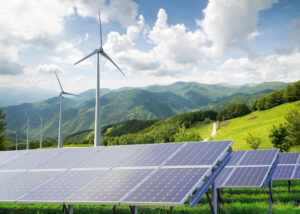
Wind and solar power in the first half of 2024 surpassed coal power in terms of capacity for the first time in Chinese history, the South China Morning Post (SCMP) reports, citing a report by the China Electricity Council (CEC). Thus, the share of wind and solar generation amounted to 38.4% (1180 GW) of the total installed capacity of 3070 GW, while the share of coal fell to 38.1% (1170 GW).
The CEC expects China to add about 300 gigawatts (GW) of solar and wind power to the grid this year, bringing their combined capacity to more than 40% of the total installed capacity of 3,300 GW of all energy sources.
China, which is currently the world’s largest consumer, producer and importer of coal, will reduce its share in the energy balance to 37%, according to the SPP.
According to Rystad Energy analysts, the reason for this change is the growing emphasis on cleaner energy sources and the country’s rejection of fossil fuels. Until 2016, about 50 GW of coal-fired power plants were built annually in the country, but at the same time, China began to make significant investments in renewable energy.
Since 2020, the annual commissioning of wind and solar power plants has consistently exceeded 100 GW, which is three to four times more than the increase in coal capacity. Since then, this momentum has only gained momentum, and last year China set a record by increasing solar and wind power capacity by 293 GW.
The dynamics in coal power, on the contrary, is declining: in 2023, about 40 GW of coal generation was added, and in the first half of 2024, according to Rystad Energy, only 8 GW. “The government has imposed stricter restrictions on new coal projects to meet its carbon reduction targets. Efforts are now focused on phasing out small coal-fired power plants, modernizing existing ones to reduce emissions, and ensuring that new projects meet stricter standards. As a result, the annual gap in capacity expansion between coal and clean energy has increased dramatically, reaching a 16-fold difference in the first half of 2024,” the experts say.
Rystad Energy analysts predict that by 2026, only solar energy will surpass coal as the main source of energy in China. Thus, the total capacity of solar generation will exceed 1.38 terawatts (TW), which is 150 gigawatts (GW) more than coal capacity.
At the same time, clean energy in China faces significant challenges such as low utilization and interruptions as capacity grows. According to Rystad Energy, solving these problems requires significant improvements to the power grid to increase transmission flexibility and storage capacity. Batteries will also be critical to maintaining grid reliability, ensuring that stability is maintained while clean energy expands to meet the needs of a growing population.
CHINA, China aims to peak CO2 emissions by 2030 and achieve carbon neutrality by 2060. As part of this plan, Coal Energy, the share of non-fossil energy consumption should rise to about 25% by 2030. solar energy
© 2016-2025, Open4Business. All rights reserved.
All news and diagrams placed on this Web site is made for internal use. Its reproduction or distribution in any form are welcome in case of placing a direct hyperlink to a source. Reproduction or distribution of information which contains Interfax-Ukraine as a source is prohibited without the written permission from the Interfax-Ukraine news agency. Photoes placed on this site are taken from open sources only; rightholder are welcome to make demands to info@open4business.com.ua , in this case we are ready to put your copyright to a photo or replace it.